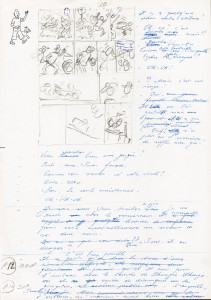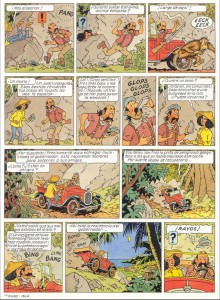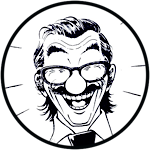A few days ago we reported about 2 drawings which were put up for auction by the Liège based auction house BD Enchères (aka Les Carmes Ltd.). The 2 drawings went for quite low prices, allotment 413 (which we discussed in last week’s article) went for 125 Euros, that’s 150 Euros all costs included. Allotment 414, which we will discuss more in detail today, reached 60 Euros, or 72 Euros with all costs included. The two items were estimated to reach between 80 to 150 euro per piece so it’s safe to say that the auction reached its goal.
The auction house was so friendly to send us some better quality scans so we can get a better view on things. We will also adapt the previous post in the next days and will inform you via our Facebook page when done.

Allotment 414 offers a sketch plus a synopsis for what is said to be the page 12 of the Barelli album “Barelli à Nusa Penida (volume 2)” which originally was published in Tintin 10/1951 – 20/1952.
However, if you look closely you’ll notice that this page comes from the version Bob De Moor made later on when pages were added to this adventure for an album release. You’ll find it on page 14 of the Le Lombard version from 1983 for instance.

In the sketches you’ll recognize the sequence which comes right after Anna Nannah meets Mario for the first time. A monkey starts shooting at both after which they descend the road in the super old wreckage Mario uses as his car while Mario informs Anna Nannah that Barelli and Moreau are in danger. Note however that Bob De Moor changed the gag later on. Whereas the first 2 strips in this synopsis talk about Mario‘s monkey (Sumba) drinking alcohol (and firing a gun as you can see in the drawings), in the final version De Moor would let the orangutan be a wild monkey only shooting the gun and not drinking from Mario‘s bottle of rum. Also in this early synopsis Sumba returns at the end of the page.
The page we added on the left to show you the final version comes from a Spanish version of the album (here it’s actually page 28 in the album due to a different cutting of the pages with an alternative ending at page 33).
Sure is that De Moor was still working on the texts as several text lines were barred and rewritten, so it’s probably the first version of that page which we see here sketched out. The drawings itself on this page were realized with pencil while the text was written in pen. You will also notice that the drawing was made on an A4 paper of the ‘Journal Tintin‘.
